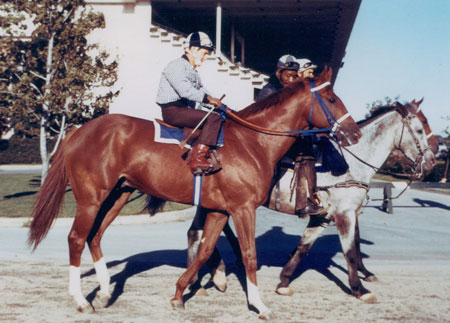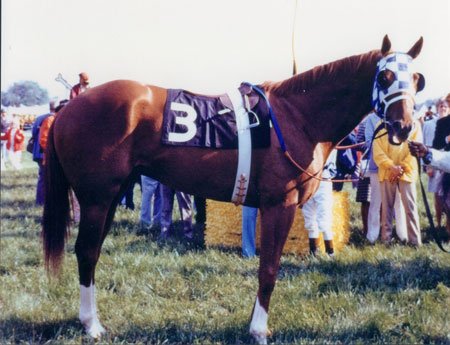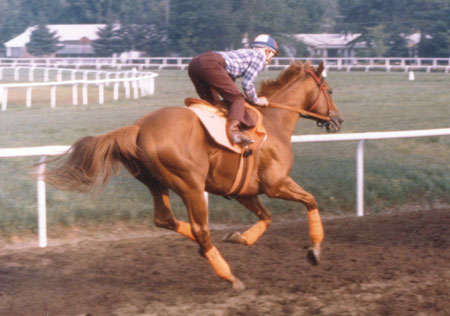We recently wrote about the possibility of I’ll Have Another sweeping the Triple Crown. So what if we’re getting ahead of ourselves. After 34 years (and we’ve been there through all of them) we’re entitled to think or dream ahead.
So, does the son of Flower Alley have the ideal preparation and foundation for such a daunting task? Not if you go by history. But racing over the past several years has said the heck with history on numerous occasions. We have always maintained that the next Triple Crown winner will be a classy 2-year-old with a good foundation, preferably a horse who ran big in the Champagne Stakes (gr. I), the only juvenile stakes to test a horse’s speed, stamina, and class. There is a reason why the last three Triple Crown winners all finished first or second in the Champagne.
Well, as it turned out, Champagne winner Union Rags lost all chance in the Derby and missed his opportunity to take the first leg of the Triple Crown, through no fault of his own.
So, with the Champagne angle gone, does I’ll Have Another have enough foundation under him to emerge victorious from the Derby and Preakness and still have enough in reserve to add the grueling Belmont Stakes, all in the span of five weeks? One thing every Triple Crown winner had in common was that they all had a series of races close together at some point in their career to prepare them for what they will have to encounter in the Triple Crown.
Noted racing author and historian Richard Sowers, with whom we’ve exchanged ideas with on numerous occasions over the years, supplied his usual comprehensive data on the subject of the Triple Crown.
Said Sowers, who has just completed the ultimate factual book on racing:
“Although Sir Barton won the Derby off an eight-month layoff and had only six starts before then, he ran four times in August of his 2-year-old campaign and again on September 14. And he ran in the Withers 10 days after the Preakness and 18 days before the Belmont.
“Although Gallant Fox ran only eight times before the Triple Crown, seven of those races were at 2, and his first four races were in a span of 34 days, and his next three races were in a span of 19 days.
“The last seven of Omaha's nine starts at 2 came in a span of 57 days. After a seven-month layoff, he ran only twice before the Derby. His first start back was 12 days before the Derby, and his second was five days later. And, with the Belmont four weeks after the Preakness, he also ran in the Withers, which was halfway between the Preakness and Belmont.
“While War Admiral didn't even run twice in the same month in his six races at 2, his first start at 3 was 24 days before the Derby, his second 10 days later, and the Preakness was a week after the Derby.
“Whirlaway ran 16 times as a 2-year-old. Nine races, his second through 10th starts, came in a span of 68 days. He then got 24 days off before he ran six more times in a span of 52 days. Whirlaway then ran twice in February, twice in March and three times in April before the Derby, then ran in an allowance at Belmont 10 days after the Preakness and 18 days before the Belmont.
“Count Fleet made his first six starts in a span of 52 days. He then got 20 days off before running twice in five days. He then got a month off before racing seven times in the next 57 days. He then took six months off, made his first start as a 3-year-old 18 days before the Derby and his second and final start before the Derby four days later.
“The first six starts of Assault's career came in a span of 64 days. After a month off, he ran twice in eight days. Assault then took six months off and made three starts at 3 before the Derby. His first start at 3 was 25 days before the Derby, his second was 11 days later and his third 10 days after that---and just four days before the Derby.
“Citation's schedule wasn't as compact as some, but he ran three times in 24 days in his fourth through sixth starts at a juvenile. After running nine times at 2, Citation got only three months off, then made his first four starts at 3 in a span of 27 days. He then got a little more than seven weeks off before making three starts in 16 days, with the last of those coming four days before the Derby.
“Secretariat's first three starts came in a span of 28 days. After running nine times at 2, he got four months off, then made his second start at 3 three weeks after his first, his next start two weeks later and his fourth start (Derby) two weeks after that.
“Seattle Slew ran only three times at 2, but those three starts were in a span of 27 days.
“Affirmed's nine starts at 2 were relatively spaced out, but he did race three times in a span of 24 days. After about four and a half months off, Affirmed made four starts in 40 days, then took 20 days off before the Derby.”
So, every Triple Crown winner was more than equipped to handle the three races in five weeks. They’d all done it before.
“Prior to Citation, the lack of winter racing forced a lot of the trainers who won the Triple Crown to run compacted schedules,” Sowers said. “But even since, they've all run some sort of compacted, busy schedule BEFORE the classics. I'm just convinced that, until SOME horse has the kind of foundation that enables him to get used to racing essentially an average of once a week for five or six weeks, obviously with layoffs, that there won't be another Triple Crown winner. We've seen 11 straight that won the Derby and Preakness fail in the Belmont, and I think insisting that horses be ‘fresh’ for the Derby makes sense for the Derby, but not for the Triple Crown. Without the foundation of running so often at least once before the classics, they're just not going to win a 1 1/4-mile race after a layoff, then come back two weeks later to win at 1 3/16 miles, then three weeks later at 1 1/2 miles.”
In regard to I’ll Have Another, he certainly was fresh going into the Derby and, like many Derby winners, has a good chance of continuing that roll, or adrenalin high, in the Preakness. But what about coming back in three weeks and going a mile and a half?
Unlike previous Triple Crown winners, top-class horses nowadays simply do not run with their races spaced that close together. So, the next Triple Crown winner likely will have to break new ground. I’ll Have Another did make his first three career starts within a two-month period, which doesn’t compare to the aforementioned horses, but still provided him with at least some kind of experience racing steadily at 2, as abbreviated as it was. At 3, by not running for two months following his first start back, he will have to undergo a dramatic change in his 3-year-old routine.
If you want to convince yourself he’s capable of doing it, then you have to think Smarty Jones, who nearly pulled it off with his speed and class. And that was with a pedigree not nearly as strong as I’ll Have Another’s, and the inability to settle in the Belmont with three jockeys out to get him beat. But what helped Smarty get as close as he did to winning the Belmont anyway was a four-race foundation at 3, all of them stakes wins, to go along with his tremendous talent. He also was tons the best 3-year-old that year, having demolished his opponents in the Preakness.
I’ll Have Another obviously still has to get by the Preakness, but if he does, at least one can get an idea how he stacks up with past Triple Crown winners. As we mentioned yesterday, he has the speed, the class, and the stamina, and he settles well, which will all help greatly.
Racing has changed dramatically in the way horses are trained and raced, and it’s going to take an exceptional horse to sweep the Triple Crown without having that group of races bunched together somewhere in his career. If I’ll Have Another can win the Preakness, save something in the tank, and then use his speed, class, and stamina to reach deep within himself and pull out that final eighth of the Belmont Stakes, just maybe he can actually pull it off.

Secretariat - Photo by Steve Haskin

Secretariat - Photo by Steve Haskin

Seattle Slew - Photo by Steve Haskin

Affirmed - Photo by Steve Haskin




